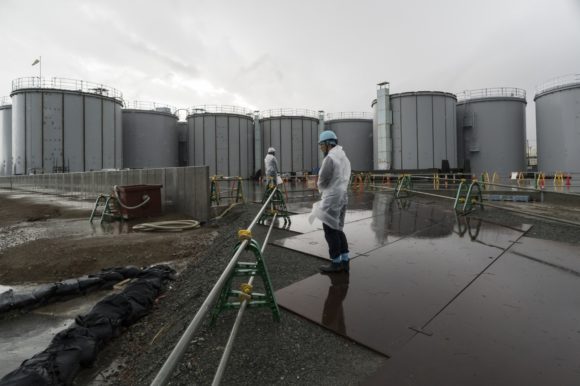Japan is planning to release millions of gallons of treated radioactive water from its wrecked Fukushima Dai-Ichi nuclear power plant into the Pacific Ocean, Kyodo News reported, citing unidentified people close to the matter.
The government has agreed on this plan and an official decision by the cabinet is expected as soon as this month, according to the news agency. The verdict ends years of debate over how to dispose of roughly 1 million cubic meters of the water, enough to fill 400 Olympic-sized swimming pools, that leaked into the power stations that suffered core meltdowns after an earthquake and tsunami in 2011.
The release likely won’t occur for another two years and could take decades to complete, Kyodo said. Storage tanks for the water at the site are forecast to be full by mid-2022.
“It’s not true that the government has decided on a direction, or the timing for a decision,” Chief Cabinet Secretary Katsunobu Kato told reporters in Tokyo on Friday. “On the other hand, to avoid delaying the decommissioning of the Fukushima Dai-Ichi plant, it is true that we can’t put off forever a decision on how to dispose of the treated water.”
The government must compile many comments on the issue from the fishing association and others, and have a deep internal discussion before coming to a decision, Kato said.
Dumping the water into the ocean threatens to hurt Japan’s relationship with South Korea, and comes despite opposition from environmental groups and the local fishing industry, which is still struggling to recover from the disaster. Discharges are a common practice in the atomic-power industry and would likely meet global guidelines.
The release of the water “could deal a fatal blow to the future of Japanese fishery,” said Hiroshi Kishi, the chairman of the Federation of Japan Fisheries Cooperatives. “We absolutely oppose to the release of the water.”
A METI panel recommended in February that the water should be released into the ocean or evaporated. Any water that is released into the environment will be re-purified and diluted to meet standards and the discharges would take place over decades, the ministry has said.
While Tepco, or Tokyo Electric Power Company Holdings Inc., cycles in water to keep fuel and debris cool, about 180 cubic meters of contaminated water is pumped out of the reactor daily due to a steady flow of groundwater into the wrecked building. The tainted water is pumped out and run through a purification system called the Advanced Liquid Processing System, or ALPS, then stored in one of more than 1,000 tanks at the site.
The effort is part of the power utility’s $200 billion effort to clean up the worst atomic accident since Chernobyl.
The treated water contains tritium, a form of hydrogen that has two extra neutrons, making it weakly radioactive. While tritium’s beta particles, those emitted during radioactive decay, are too low-energy to penetrate the skin, they can build up in the body if inhaled or consumed.
The International Atomic Energy Agency said in a report in April that it is ready to work with Japan “to develop a framework to provide radiation safety assistance before, during and after the disposition” once a decision on how to proceed has been made.
About the photo: Storage tanks for radioactive water at the Fukushima Dai-ichi nuclear power plant on Jan. 29.
Was this article valuable?
Here are more articles you may enjoy.


 ‘Super Roofs’ Are Rewarding Insurers, Cat Bond Investors and Homeowners
‘Super Roofs’ Are Rewarding Insurers, Cat Bond Investors and Homeowners  How Three New CMS Policies Impact Workers’ Comp Claims
How Three New CMS Policies Impact Workers’ Comp Claims  Florida And East Coast Will See Big Losses From More Cat 5 Storms, Researchers Say
Florida And East Coast Will See Big Losses From More Cat 5 Storms, Researchers Say  Standard Chartered Settles $2 Billion Iranian Sanction Suit in London
Standard Chartered Settles $2 Billion Iranian Sanction Suit in London 